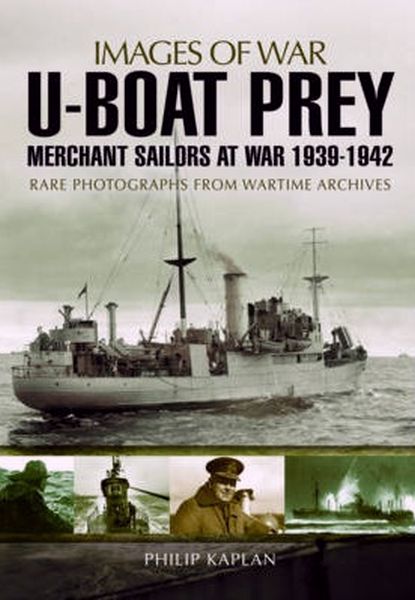| Title: | U-Boat Prey |
| Subtitle: | Merchant Sailors at war 1939 -1942 |
| Author: | Kaplan, Philip J. |
| Editor: | Pen & Sword Maritime |
| Published: | 2014 |
| Pages: | 128 |
| Language: | English |
| ISBN: | 9781783462940 |
| Review: |
"U-Boat Prey" is an issue of Pen & Sword in the series "Images of War" . This series in the meantime consists of almost 100 books based on a rare collection of images or graphic pictures complemented with under titles and lively descriptions. Most of the time the books treat a specific campaign or weapon from the Second World War, but some editions of the series concern subjects of other conflicts like the War in Korea or the Balkan War. As the books from the series generally do not contain a large number of pages and as a standard are carried out in soft cover, they are very affordable. Because of this accessibility the series enjoys a growing success. "U-Boat Prey" concerns the first years of the Battle for the Atlantic Ocean, seen through the eyes of the victims. These are, as is made clear in the subtitle "Merchant Sailors at War 1939 -1942", the crews of the many sunken merchant ships. During the Battle for the Atlantic Ocean over 3,500 allied merchants have been sunk, of which almost 2,500 fell victim to submarines. The remaining 1,000 disappeared beneath the waves as a result of air raids, attacks by surface raiders, coastal batteries or mines. For a merchant seaman a submarine attack was a true nightmare as it appeared completely out of the blue. As a predator in the night the U-boat always struck unexpectedly. As Great Britain, being an island nation, was completely dependent on supply by sea, from the beginning of the Second World War all available commercial ships were applied in an attempt to keep the supply chain going. In the beginning of the war the supply across the sea had not yet been properly organized causing in 1939 and 1940 alone 1,100 allied merchant ships to get sunk. By the introduction of convoys, better escorts and armament of the merchant ships themselves this number in 1941 was decreased to 850, but in 1942 the number of German submarines had increased so much that in that year alone 1,200 allied ships disappeared in the waves of the Atlantic Ocean. The number of ships destructed in the first half of the war therefore was larger than the number of ships that could be launched . The allies threatened to lose the Battle for the Atlantic Ocean. By having the convoys escorted by auxiliary aircraft carriers, the introduction of improved radar systems, but mainly by introducing long range aircraft this could be countered from 1943 onwards. The Germans were no longer able to replace the destroyed U-boats and the allied losses were drastically reduced to 575 lost ships in the years 1943 up to and including 1945. Apart from that the lost vessels could be replaced by new, mainly large numbers of American ships which could be constructed with dazzling speed. The author Philip J. Kaplan, who wrote already a number of books about military subjects, of which two for the series "Images of War" has a smooth style and "U-Boat Prey" therefore is easy to read. The reader however has to have a wider knowledge of the Second World War as the author refers to many happenings and crucial battles without elucidating those any further. But as said, the series "Images of War" is based on collections of little or never published pictures which has been underlined by their second subtitle: "Rare photographs from Wartime Archives". The pictures in the book which are really exceptional are a hook-up for the pieces of text that do not dig deep into the subjects. Therefore the sequence in which the text is being presented is not chronological but has been defined by the choice of the subjects of the various chapters. "U-Boat Prey" is less suitable as a book of reference, but excellently complimentary to the existing literature. |
| Review: | |
Information
- Translated by:
- Fred Bolle
- Article by:
- Peter Kimenai
- Published on:
- 27-06-2014
- Last edit on:
- 28-06-2014
- Feedback?
- Send it!




